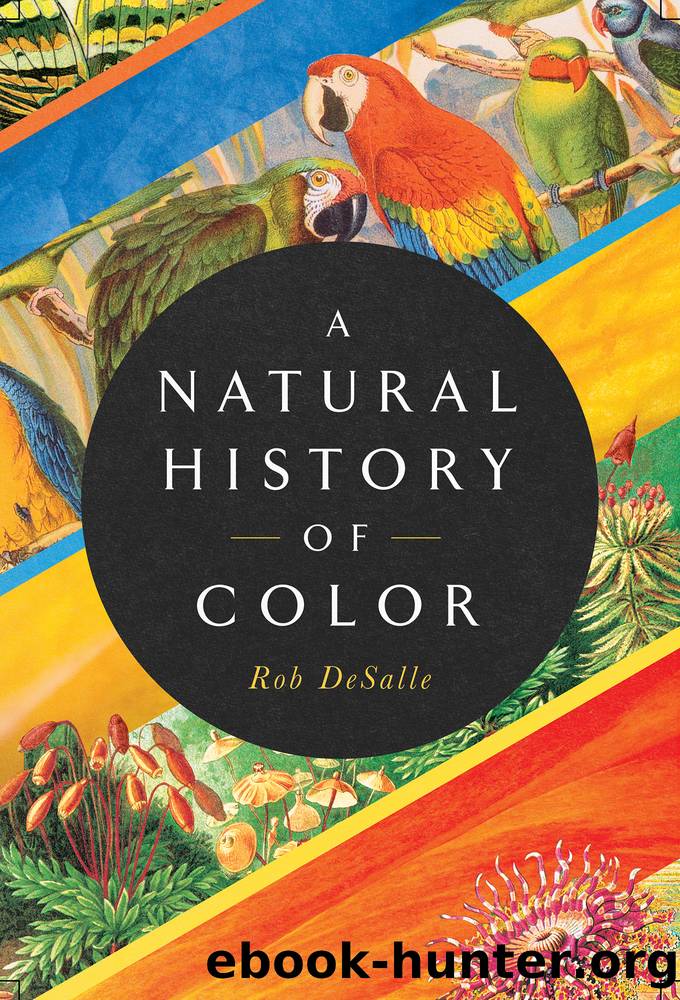A Natural History of Color by Rob Desalle

Author:Rob Desalle [Desalle, Rob]
Language: eng
Format: epub
ISBN: 9781643134437
Publisher: Pegasus Books
Published: 2020-07-06T23:00:00+00:00
Mimicry
It stands to reason that since natural selection doesn’t have a conscience, any and all strategies for survival will eventually get a chance. Cheating has become one of the best and most “economical” strategies of them all. Cheating is simply a way of life on our planet. Why wouldn’t one species take advantage of the difficult chemical properties of another species? Looking like something dangerous, toxic, poisonous, or smelly without being so is a major cheat strategy that has been adopted by millions of species in the history of our planet. Sometimes it is more economical in an evolutionary sense to look like something dangerous than to make yourself dangerous, so mimicry gets a foothold in many ecological systems. Mimicry can also include looking like something else that predators will avoid because of disinterest, like a dead leaf or a stick. And coloration has been a major factor in all kinds of mimicry.
We have already mentioned mimicry in the context of the monarch butterfly. Again we return to Larson, who refers directly to animal mimicry in many of his cartoons; his best cartoon on the topic is titled “When animal mimicry breaks down.” It shows a hunter dressed in full winter hunting clothing, kneeling on the ground with his trusted rifle. A tall figure that is obviously a forty-five-point buck dressed in hunter attire stands behind him, annoyingly saying, “Howdy! Any luck? The vacuum bag is hot today! Any luck? Howdy!” Apparently, the reference to the vacuum bag gives the poor buck’s mimicry of a hunter away. Mimicry is only effective when there is a model and the mimic is as true to the model as possible.
Here we will discuss two model mimic systems that cover a lot of mimicry ground: milk snake-coral snake mimicry and Heliconius butterfly mimicry. The first because some of the genetic machinery behind the color patterns in mimicry is known, and the latter because it is somewhat imperfect and through its imperfection teaches us a lot about how color mimicry works in nature. Before going to these amazing animal systems, some terminology is necessary. In the decades following the introduction of the idea of natural selection, many novel ways of viewing nature arose. One naturalist named Henry Walter Bates made trips to the Amazon right after Origin of Species was published. He described in detail several cases of similarly colored insects in Brazilian rain forests. The phenomenon of an obnoxious or poisonous species being copied by a harmless species was affectionately named after Bates and is called “Batesian mimicry,” in honor of his pioneering work. Theodor (Fritz) Muller, a German natural historian, came along a decade or so later and recognized that in many cases, an aposematic species would be copied by another species that also developed a toxic taste. This form of mimicry was given his name and is now known as “Mullerian mimicry.” Today, naturalists refer to the grades between Batesian and Mullerian mimicry as Quasi-Batesian and automimicry. Quasi-Batesian refers to the recognition of a kind of mimicry system that at first appears as Mullerian (i.
Download
This site does not store any files on its server. We only index and link to content provided by other sites. Please contact the content providers to delete copyright contents if any and email us, we'll remove relevant links or contents immediately.
| Anesthesiology | Colon & Rectal |
| General Surgery | Laparoscopic & Robotic |
| Neurosurgery | Ophthalmology |
| Oral & Maxillofacial | Orthopedics |
| Otolaryngology | Plastic |
| Thoracic & Vascular | Transplants |
| Trauma |
When Breath Becomes Air by Paul Kalanithi(7255)
Why We Sleep: Unlocking the Power of Sleep and Dreams by Matthew Walker(5637)
Paper Towns by Green John(4164)
The Immortal Life of Henrietta Lacks by Rebecca Skloot(3820)
The Sports Rules Book by Human Kinetics(3581)
Dynamic Alignment Through Imagery by Eric Franklin(3482)
ACSM's Complete Guide to Fitness & Health by ACSM(3459)
Kaplan MCAT Organic Chemistry Review: Created for MCAT 2015 (Kaplan Test Prep) by Kaplan(3418)
Introduction to Kinesiology by Shirl J. Hoffman(3297)
Livewired by David Eagleman(3116)
The River of Consciousness by Oliver Sacks(2989)
Alchemy and Alchemists by C. J. S. Thompson(2908)
The Death of the Heart by Elizabeth Bowen(2896)
Descartes' Error by Antonio Damasio(2728)
Bad Pharma by Ben Goldacre(2722)
The Gene: An Intimate History by Siddhartha Mukherjee(2488)
Kaplan MCAT Behavioral Sciences Review: Created for MCAT 2015 (Kaplan Test Prep) by Kaplan(2485)
The Fate of Rome: Climate, Disease, and the End of an Empire (The Princeton History of the Ancient World) by Kyle Harper(2430)
The Emperor of All Maladies: A Biography of Cancer by Siddhartha Mukherjee(2427)
